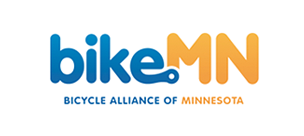
Thanks to the efforts of our lobbyists, advocacy committee, staff, members, and community who met with legislators at our Minnesota Walk Bike Summit in February, BikeMN has several wins to celebrate from this year’s legislative session. This work is only possible because of generous support from our members like you! Find ways to support our work here, and thank you!
In the months prior to our Summit event, the Advocacy team met weekly to plan, prepare, and collaborate on some of the language included in HF5247. The omnibus bill includes a number of changes and addendums affecting how we bike, walk, and roll in Minnesota. A few of the key points that we especially want to highlight include:
Updating the Ebike classification system:
The ebike classification system will continue to include the following classes:
- Class 1 (up to 20 mph pedal assist with no throttle)
- Class 2 (up to 20 mph pedal assist with a throttle),
- Class 3 (up to 28 mph pedal assist with no throttle)
- With the new addition of a“Multiple mode”. This means that a bike can be switched or programmed between 1 – 2 of the classes referenced above.
The bill language also includes clarification on what is NOT an ebike:
“A vehicle is not an electric-assisted bicycle if it is designed, manufactured, or intended by the manufacturer or seller to be configured or modified to not meet the requirements for an electric-assisted bicycle or operate within the requirements for an electric-assisted bicycle class.”
If, for example, the speed governor on an ebike has been cut, modified, or tampered with, that vehicle is not an electric-assist bicycle. If an ebike is modified so it no longer fits within the legal classification system, it must be registered, the operator needs to be licensed and have insurance coverage. Anyone under the age of 15 is not legally allowed to operate an ebike. This has always been the law.
The manufacturer or distributor of an electric-assisted bicycle must apply a permanently affixed label in a prominent location on the bicycle. The label must contain the classification class number, top assisted speed, and motor wattage. A multiple mode electric-assisted bicycle must have labeling that identifies the highest class or each of the electric-assisted bicycle classes in which it is capable of operating.
In order to understand the challenges associated with the rapid rise in popularity of ebikes among riders between 15 – 18 years of age, the Traffic Safety Advisory Council and the Active Transportation Advisory Councils are tasked with bringing key stakeholders together to study the issue and prepare a legislative report by February 2026. This report will be used to inform any future legislative needs to regulate the use of ebikes to improve safety among our youth.
Updated Driver’s Education
Currently, the MN Driver’s Manual does include information about the rights of bicycles on the road, but up until now there have been no details on how to deliver the information. The changes outlined in the bill now mean that MN Driver’s Education must include information on:
- The rights and responsibilities of vulnerable road users
- The specific duties of a (motor vehicle) driver when encountering a bike, other non motorized vehicle, or pedestrian
- The safety risks for vulnerable road users
- Best practices to minimize dangers and avoid collisions with vulnerable road users
BikeMN’s People Friendly Driver webpage is a great place to learn more about sharing the road with people who bike, walk, and roll!
Complete Streets
The state defines Complete Streets:
“‘Complete streets’ is the planning, scoping, design, implementation, operation, and maintenance of roads in order to reasonably address the safety and accessibility needs of users of all ages and abilities. Complete streets considers the needs of motorists, pedestrians, transit users and vehicles, bicyclists, and commercial and emergency vehicles moving along and across roads, intersections, and crossings in a manner that is sensitive to the local context and recognizes that the needs vary in urban, suburban, and rural settings.”
BikeMN advocated for Complete Streets to be considered in infrastructure and designs, especially those that are frequently used by people who bike, walk, roll, and take transit. The additional language means the complete streets policy must be considered from the beginning of a project as well as through the design and implementation of infrastructure plans. Throughout the process, a complete streets plan for proposed infrastructure must be integrated in the plan, and must be used to evaluate the inclusion of active transportation facilities in a project. The needs and safety of all users must be considered in phasing of projects where important decisions are made. These considerations include speed, number of lanes and intersection design, etc..
Keep Us Rolling…
BikeMN is excited about the policy changes as a result of this year’s legislative session. As a statewide leader in bicycle and pedestrian safety and education, we will continue to develop and facilitate policy initiatives as well as educational programs to educate our communities so that everyone can bike, walk, and roll easily and safely.
We couldn’t do this work without you! As a 501(c)(3) we rely on support from our members across Minnesota. Find ways to support our work here.
